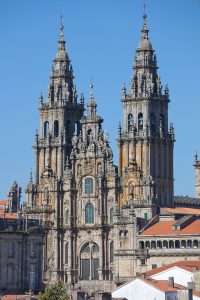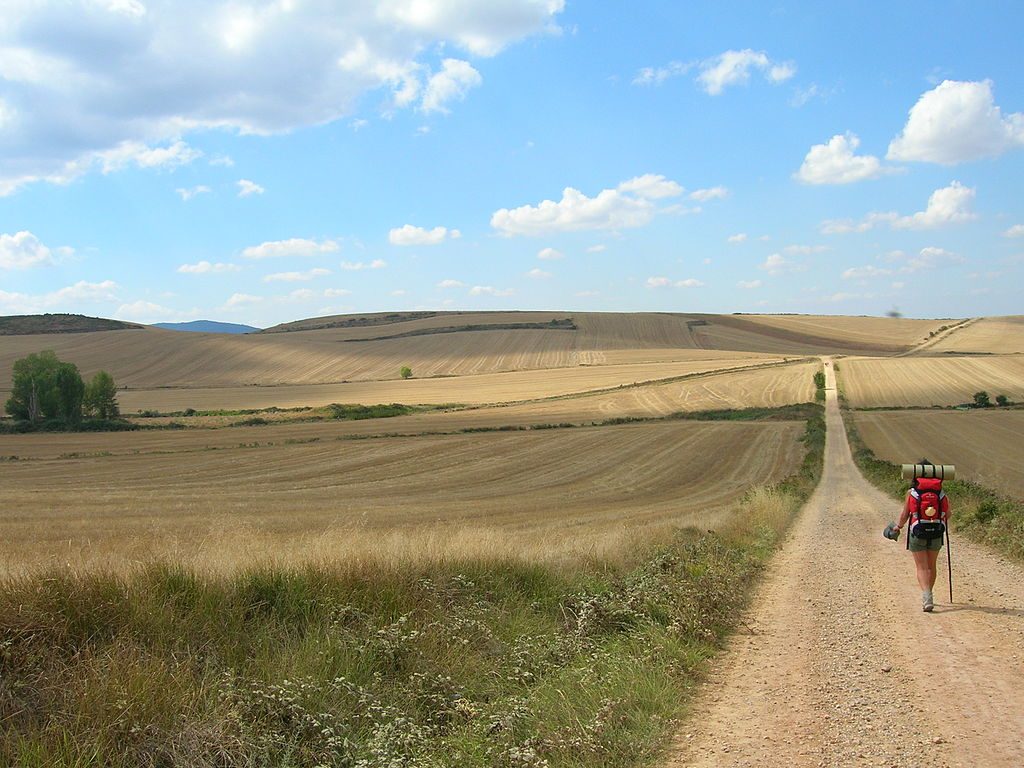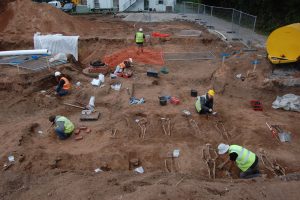
There’s nothing wrong with pilgrimage being used to describe many kinds of journeys or experiences. But it’s helpful to remember that, in the Christian tradition, spiritual pilgrimage describes, above all, our daily and life-long journey to the Jerusalem of our heart—to Jesus. There’s no way to idealize that journey! It is, at its best, lengthy, difficult, and unsafe.
It’s also easy to gloss over some of the harsh historical realities of physical pilgrimage. Take, for example, the Camino de Santiago, or the Way of St. James—the network of routes leading to the shrine of St. James in Santiago de Compostela, in northwestern Spain. The Camino was one of the most traveled pilgrimage routes in the Middle Ages and is experiencing a surge of popularity in our time. It’s estimated that in 2014, over 200,000 people walked this route.
I’ve yet to walk the Camino, but I certainly want to. One reason? It’s become so romanticized that it looks appealing. I don’t like physical exercise of any kind, yet when I see photos of pilgrims on the Camino, I’m ready for a three-month trek, just me and my backpack. I’m not so sure the Camino was this enticing in the Middle Ages. In fact, I would argue that this route has been almost entirely cut off from its medieval meaning.

“Anyone can do it.” So why did medieval pilgrims do it? What made the Camino so popular? I assume the scenery was just as beautiful in the Middle Ages, but for the most part medieval pilgrims didn’t walk the Camino for adventure. I’d like to think they walked it as a way to practice or renew their faith. St. James, after all, was said to have brought the Gospel to Iberia and was thought to have been buried there after he was beheaded in Jerusalem. Compostela was a little piece of the Holy Land brought to Spain.
I’m sure faith was one goal, but there were others, and not all of them were pretty. I doubt the spectacular scenery would have made up for some of the situations that brought pilgrims to this route.
Let’s take a brief look at three reasons medieval pilgrims hit the road to Saint James:
Vows – People who were sick or in danger often called upon a saint to help them, making a vow to go to the saint’s shrine should they be delivered. Reneging on such a vow could prove dangerous! The 12th-c. Miracles of St. James tells about a French soldier who vowed to go on pilgrimage to Compostela if St. James helped him in battle. St. James came through. The soldier went back on his vow and became ill to the point of death. Only when he began making plans for a pilgrimage did he regain his health. He completed the journey with the help of the saint. Making pilgrimage vows that were subsequently regretted seems to have been common, which means that many travelers on the Camino didn’t even want to be there.
Miracles – Most pilgrimage saints were revered for performing miracles of healing. St. James was no exception. Many pilgrims on the Camino would have been ill, perhaps even (literally) on their last leg. “The old pilgrimage roads must have been choked with the sick and dying,” muses historian and pilgrim Conrad Rudolph.* For such travelers, a pilgrimage was a journey of desperation.
 In fact, sick pilgrims have just made the news, some 900 years after their journey. A news story from yesterday reports that around 50 graves have been found at the pilgrimage site of Lichfield in England. The graves may belong to pilgrims who traveled to the relics of St. Chad in hopes of healing but died there or en route. The photo of archaeologists digging up these graves is sobering and drives home the point that not all pilgrims survived their journey.
In fact, sick pilgrims have just made the news, some 900 years after their journey. A news story from yesterday reports that around 50 graves have been found at the pilgrimage site of Lichfield in England. The graves may belong to pilgrims who traveled to the relics of St. Chad in hopes of healing but died there or en route. The photo of archaeologists digging up these graves is sobering and drives home the point that not all pilgrims survived their journey.
Penance – We think of pilgrimage as a voluntary journey. But in the Middle Ages, many pilgrims were ordered by a civic court to walk to Compostela. Pilgrimage was considered to be an appropriate sentence for sexual and political crimes and even for murderers, who might walk the road with models of their weapons chained to their bodies. Read my recent essay about one of my favorite 15th-century artists who got sent on a penitential pilgrimage to a shrine along one of the Camino routes.
These weren’t the only reasons to take to the road in the Middle Ages. But even this short review shows that pilgrimage was not quite the enchanting walk pictured in travel photos today. In the Middle Ages, your traveling companions would not have been like-minded friends on a bit of a hike or a journey of self-discovery. They would have been distinctly . . . unsavory. They were people who had reneged on vows; who carried disease or were near death; who had committed crimes. Was pilgrimage comfortable or safe? No. Was it worth it? I’m glad I don’t have to answer that question.
Have you walked the Camino or another pilgrimage route? What was your motive or experience? I’d love for you to leave a comment below.
Be sure to tune in next week. I’m excited that Jeremiah Gibbs will be here to tell us about his experiences with the Camino!
*Conrad Rudolph, Pilgrimage to the End of the World: The Road to Santiago de Compostela (Chicago: University of Chicago Press, 2004), 5.
Hello Lisa. I am a fellow A-FFN member from Epiclesis Church in Sacramento who has walked the Camino de Santiago twice. The first time was in 2013 when I walked the Camino Frances from St. Jean Pied de Port to Santiago. This was 790km (500 miles). The second time was from Leon to Santiago (257 miles). Just got back from that one on September 23. My wife Heather accompanied me on the latter. Both of these experiences were, to say the least, life-altering. I would love to be able to dialogue with you in depth about the pilgrimage experience and prayer walking in particular. By any chance, are you planning on being at the A-FFN Conference in June? In Florida? I have tentative plans to attend.
Donald
Hi Donald – thanks for telling us about your experiences with the Camino! I can’t wait to read more about it in your blog. I hope to be at AFFN in June but I’m not certain yet. I was there last June. Either way I’d love to talk to you more about your pilgrimage experience.
Lisa, great to hear from you. The blog I wrote and am still writing is more of a travelogue, and really meant to be nothing more. The deep lessons of the Camino are profound and confined to personal reflections and meditations that I am still putting together. I love to talk about them, but I still have not put anything to paper as yet. Chris is interviewing Heather and I this coming Sunday at church, and we will share some of these things with our church community. In the meantime, perhaps there is a way we can chat either by phone or some other means before June.
Donald
It would be great to talk with you. I hope Sunday goes well – wish I could be there!
I am a pilgrim who walked the Camino February-March of 2014. It was one part of a three month sabbatical. The way I describe my Camino is that it was a pilgrimage deeper into the heart of God. My goal was not to walk the Camino – the Camino was simply the path I took (it is well suited with ready paths and accommodations). That said, my Camino was more than I hoped for and the realities of the Camino de Santiago are partially the reason.
Because I was walking in the colder, less picturesque months my pilgrimage was very much my own. I walked by myself almost every day and often did not see anyone else until I was at the albergue for the night. However, I made some very good friends. And because of the time of year I walked in very cold temperatures, much rain, and even some snow.
I do hope to return. I miss it every day. I loved walking and spending such an extended time with God. Next time my wife and I plan to go together.
Thank you, Mike. You experience sounds like it was very meaningful, and I like the way you described it — “a pilgrimage deeper into the heart of God.” If you miss it every day, it must have been unique and wonderful!
If a round of golf is ‘a good walk spoiled’ maybe a pilgrimage such as the Camino is a ‘good walk enhanced’. I have yet to read any personal account of it where the walker has been unmoved by the experience. That said, one of the issues I shall tackle in my book Journey – the way of the disciple (Paternoster Press) is the extent to which the lessons learnt on the road stay with the person who walked it. Interviews with Martin Sheen about the film The Way (directed by his son Emilio Estevez) are fascinating about the impact of the outer journey on the inner soul.